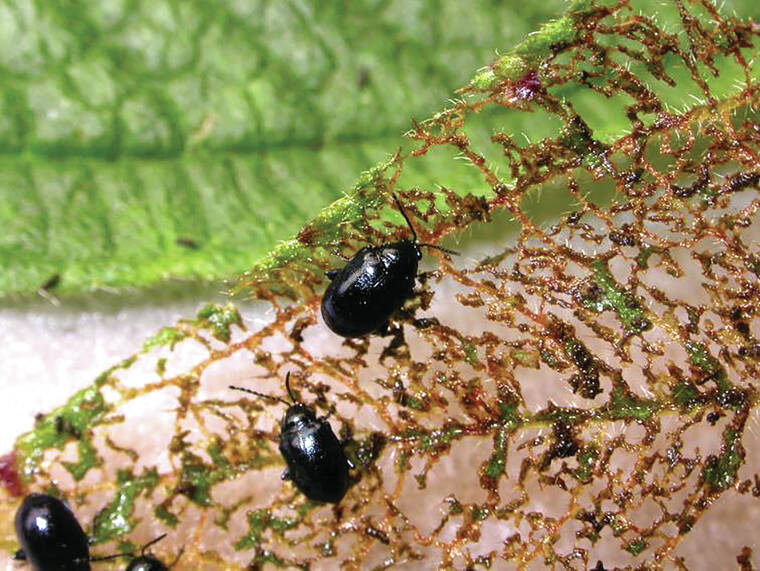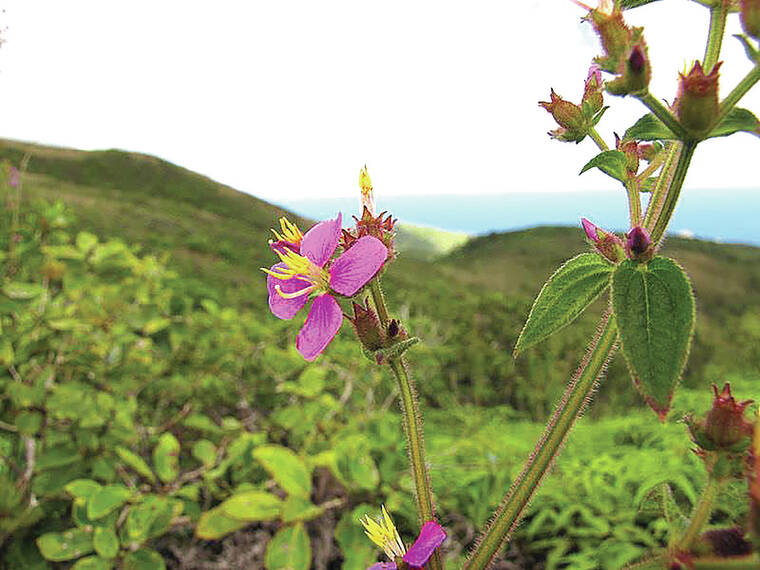The state’s proposals to introduce two insects statewide to combat invasive plants cleared another hurdle with two final environmental assessments finding the release of the two species will have no significant impact.
The state departments of Agriculture and Land and Natural Resources are planning to release on state lands a butterfly with gregarious larvae, Euselasia chrysippe, for biological control of miconia, and a beetle (Syphraea uberabensis) for control of cane tibouchina. Miconia and cane tibouchina are noxious weeds threatening Hawaii’s forests and watersheds.
Miconia, Miconia calvescens, is native to Central and South America and since its introduction in the mid-1900s has infested the Big Island and Maui, with populations cropping up on Kauai and Oahu, according to the final environmental assessment released Friday.
First introduced to Oahu in 1961 as an ornamental, Miconia reached Hawaii Island two years later. After invading forests, the miconia was declared a noxious weed in 1991 and continues to be one of Hawaii’s most threatening and invasive plants.
The miconia is a fast-growing, weedy tree that reaches 13 to 50 feet in height and features leaves that average 3 feet long and 1 foot wide with a dark green and felty top and a purple underside. Each plant can produce over 20,000 seeds per fruiting season, and each seed may remain viable for more than 16 years. Seeds are dispersed long distances by animals such as birds and rats and can be spread by wind, water, or humans.
Also shade tolerant, the miconia grows in the under-story of other species in a range of forests. It shades and out-competes other species, effectively forming a monoculture.
“Mechanical and chemical methods of control have been underway to attempt to keep the species from spreading; however, long-term management of miconia relies on biocontrol as a critical tool. Release of this proposed biocontrol agent will help to reduce tree vigor and growth, while future agents may aim to reduce seed production, population densities, and seedling establishment and survival,” the final EA reads.
E. chrysippe is a natural herbivore of miconia in Costa Rica and was found to be the most promising leaf-feeding biocontrol for the plant. The EA states extensive testing has shown it to be host-specific to miconia and other closely related members of the melastome family, all of which are non-native weeds in Hawaii.
“Miconia is an aggressive invasive species that readily encroaches upon public and private lands contributing to the shading out of native and non-native trees and undergrowth; thus, effectively disrupting healthy forests and landscape ecosystems and ultimately exposing soils to erosion. Extensive efforts and public expense have been put forth to control this tree, with little success. Today, with the outbreak of Rapid Ohea Death, it is more important than ever that Hawaii’s forests are protected from aggressive species as Miconia,” Diane Ley, then-director of the Hawaii County Department of Research and Development wrote in 2018 comments.
“A successful biocontrol candidate, such as Euselasia chrysippe, would be a welcome tool to control the further spread of Miconia through the Island of Hawaii,” Ley continued.
Spread of the insect from the initial release sites will occur both through natural dispersal and via artificial redistribution by managers between sites. Prior to release, a host of permits will need to be secured from the U.S. Department of Agriculture, state Department of Agriculture, and the Department of Land and Natural Resources.
“It is expected that E. chrysippe will range statewide within a few years of release. State and federal land management agencies will closely monitor the effectiveness of the biocontrol release,” the final EA reads.
The other approved for release insect is a beetle from Brazil, Syphraea uberabensis (Coleoptera, Chrysomelidae, Galerucinae, Alticini), for biological control of cane tibouchina, Tibouchina herbacea (Melastomataceae).
Tibouchina herbacea is a noxious weed native to Southern Brazil, Uruguay, and Paraguay. In Hawaii, it has adapted and is abundant in forests on the islands of Hawaii, Lanai, Maui, Molokai, and Oahu.
Like, miconia, it is able to invade native forest through abundant production of tiny, easily dispersed seeds. Once established it forms dense stands and displaces native vegetation.
The shrub is semi woody and can grow up to 9 feet tall with leaves that are hairy and about 3 inches long by about 1.4 inches wide. Its flowers are pink and have four petals with bright yellow anthers.
Syphraea uberabensis, also known as the Brazilian beetle, is a natural herbivore of T. herbacea in the plant’s native range in Brazil. Of the potential natural control agents evaluated in Brazil, S. uberabensis demonstrated the most potential for successful control of cane tibouchina.
Like E. chrysippe, Syphraea uberabens feeds on a small pool of closely related species, all of which are invasive weed species, and its release is expected to be beneficial to Hawaii’s forests and hydrology.
The beetle would also be released on state lands across Hawaii, requiring the same permits as E. chrysippe.


